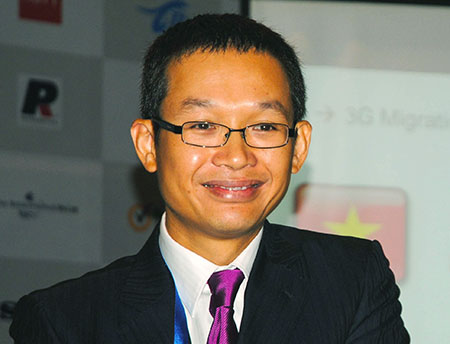Qualcomm promotes 3G technology

Could you explain Qualcomm’s technology in a simple way?
Today when you see people using smartphones to read emails, check bank accounts, download applications or post pictures to Facebook or Twitter, there’s a good chance they’re using Qualcomm’s 3G technology. Today, high-speed 3G networks are reaching every corner of the globe, and 3G technology is moving at a speed that it regularly changes how we live, work, communicate, and entertain.
According to Ericsson ConsumerLab, last year more than 20 per cent of the Vietnamese population used smartphones and 5 per cent used tablets. What does this mean for mobile applications?
Those numbers are right, and as a result mobile applications and their development trends around the world took centre stage at the Vietnam Consumer Digital World Expo (VCW) in Ho Chi Minh City last weekend. This is why Qualcomm acted as the main sponsor for the VCW expo. Another reason was Qualcomm had the opportunity to promote our technology, especially 3G, in Vietnam.
The exhibition had HTC, LG, Nokia, QMobile, and Mobistar promoting smartphones and tablets using the Snapdragon chip. What is the Snapdragon?
Snapdragon processors deliver best-in-class technologies for mobile devices all on a single chip. Many top mobile device OEMs use our latest Snapdragon processors in their flagship models. A good example is Samsung’s latest top-of-the-range smartphone, the Galaxy S4 as well as the HTC One, LG Optimus G, Sony Xperia Z Ultra and many others.
Besides standard consumer use, in what areas does 3G technology have an important role to play?
I think our 3G technology plays an important role in education, business and healthcare, though 3G use in healthcare is still in the early stages. For education, 3G technology is already being put to use in e-education and tablets are quickly becoming popular tools for students and teachers alike.
In business, there are two clear trends. The first is BYOD, or Bring Your Own Device, which is where employees bring their personal laptops, tablets, and smartphones into the business and use them to access company information and applications. It can also be used for education for students who use their personal devices to link up with their institution. The other trend is Augmented Reality, a type of virtual reality that aims to replicate the world on computers. Applications for this trend cover numerous fields, not just business.
As I said before, 3G healthcare applications are still in their infancy, but I see application in the future to be toward people who need regular care and also telemedicine.
What will Qualcomm do to promote 3G in Vietnam?
We are working with the Vietnamese government, network operators, device manufacturers and application developers to advance 3G and mobile technologies and bring them to more people in Vietnam. The plans are being finalised and the programme will start early this fourth quarter and run five months. It will be active in about 30 cities and provinces nationwide, with 100 promotion points.
Vietnam still struggles with the quality of its 3G system. What are your views on this?
Further investment is always needed, from both the government and business community. From the government side, the most important thing is to select suitable frequencies, and Qualcomm has lots of experience advising on appropriate frequencies in terms of both technology and expenditure. As the world’s largest mobile chip maker, we know which frequencies are suitable. We can also advise network operators on 3G development and enhancement.
Finally the country needs to advance 3G to 3.5G and 3.75G. This is vital to the future.
What the stars mean:
★ Poor ★ ★ Promising ★★★ Good ★★★★ Very good ★★★★★ Exceptional
Latest News
More News
- Businesses ramp up production as year-end orders surge (December 30, 2025 | 10:05)
- Vietjet chairwoman awarded Labour Hero title (December 29, 2025 | 13:06)
- How to unlock ESG value through green innovation (December 29, 2025 | 10:03)
- AI reshapes media and advertising industry (December 29, 2025 | 08:33)
- FPT and GELEX sign deal to develop blockchain tech for global markets (December 29, 2025 | 08:29)
- Vietnam’s GDP forecast to grow by 9 per cent in 2026 (December 29, 2025 | 08:29)
- Women entrepreneurs are key to Vietnam’s economic growth (December 29, 2025 | 08:00)
- Vietnam's top 500 value-creating enterprises announced (December 27, 2025 | 08:00)
- The PAN Group shaping a better future with ESG strategy (December 26, 2025 | 09:00)
- Masan Consumer officially lists on HSX, marking the next phase of value creation (December 25, 2025 | 13:20)

















 Mobile Version
Mobile Version